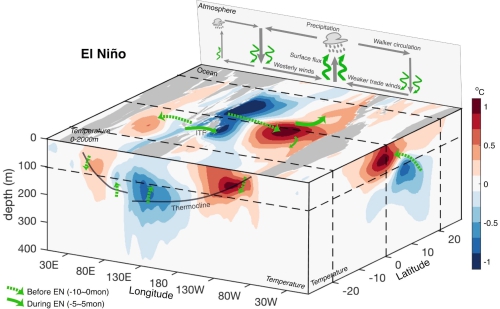The El Nino-Southern Oscillation (ENSO), the strongest inter-annual perturbation to the climate system, dominates the year-to-year variability of the global surface temperature, global weather pattern, and global/ocean energy flow. ENSO directly affects temperature, rainfall, droughts, hurricanes, extremes across the globe through the global atmospheric circulation changes.
For example, 2016 was the warmest year on record for global surface temperature by far (rather than later years of 2017 or 2018), because there was a super El Nino from 2015-2016. In another word, the global troposphere has a “fever” during El Nino, leading to many extreme events such as flooding in the southeast China.
What about the ocean? Is the ocean gaining or losing heat during El Nino? This question has been debated in the scientific community for a long time. A new study published in Journal of Climate answered this question. The study is led by Lijing Cheng from Institute of Atmosphere, Chinese Academy of Sciences (IAP/CAS), in collaboration with Kevin E. TRENBERTH (NCAR, U.S.), John T. FASULLO (NCAR, U.S.), Michael MAYER (European Centre, U.K.), Magdalena Balmaseda (European Centre, U.K.) and ZHU Jiang (IAP/CAS, China)

Schematic illustration of the ocean heat change (blue and red shadings) and heat flow (green arrows) during El Nino in the tropics (20oS~20oN). The three slices show: zonal, meridional and horizontal mean ocean temperature change during El Nino. All fields are normalized by their maximum values, so the units are Kevin and all values are within -1~1. (Image by CHENG Lijing)
The collaborated study combines ocean observations, re-analyses, and surface flux data with Earth system model simulations to obtain estimates of the different terms affecting the redistribution of energy in the Earth system during ENSO events, including exchanges between ocean and atmosphere, among different ocean basins, lateral and vertical rearrangements. This comprehensive inventory allows better understanding of the regional and global evolution of ocean heat related to ENSO.
Results confirm that there is a strong negative ocean heat content tendency in the tropical Pacific Ocean during El Nino, i.e., tropical Pacific Ocean is cooling, mainly through enhanced heat fluxes into the atmosphere driven by high sea surface temperatures. This leads to more rainfalls in the central Pacific and then drives the global teleconnections. In addition to the net heat gains and releases from ocean to the atmosphere, there is a redistribution of heat both laterally and vertically in the tropical Pacific and Indian oceans (warming within 0-100m and cooling with 100-300m). Heat is also transported and discharged from in- and off-equatorial regions during and after El Nino. Ocean heat changes outside of the tropical Pacific Ocean indicates the ENSO-driven atmospheric teleconnections and changes of ocean heat transport (i.e. Indonesian Throughflow). The tropical Atlantic and Indian oceans warm during El Nino, partly offsetting the tropical Pacific cooling for the tropical oceans as a whole.
While there are distinct regional OHCT changes, many compensate each other resulting in a weak but robust net global ocean cooling during and after El Nino. That means the global ocean is losing heat during and after El Nino.
"So our study finds that, although El Nino heats the Earth’s atmosphere, it cools the ocean!" CHENG explains their finding, “Like a person who has a fever, the climate system takes advantage of El Nino events to sweat (more rainfalls in the tropical Pacific) and release heat (into atmosphere and space)."
The study provides a more complete view of earth’s energy flow associated with ENSO, and sheds light on the ENSO forecast and extremes through an energy point of view.
Reference:
Cheng, L., K.E. Trenberth, J.T. Fasullo, M. Mayer, M. Balmaseda, and J. Zhu, 2019: Evolution of Ocean Heat Content Related to ENSO. J. Climate, 32, 3529–3556, https://doi.org/10.1175/JCLI-D-18-0607.1
